|
Vickers Vincent
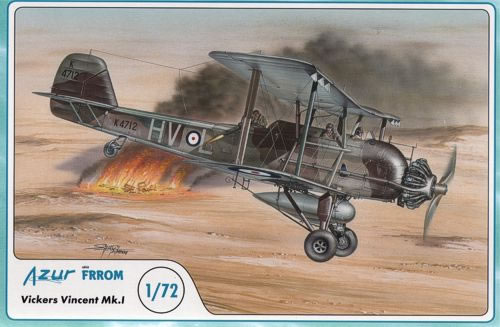
Azur serie FrRom, 1/72 scale
S u m m a r y : |
Catalogue Number: |
Azur serie FrRom Kit No. FR019 - Vickers Vincent |
Scale: |
1/72 |
Contents & Media |
85 styrene airframe parts, 5 x styrene transparencies, 24 resin engine, bomb & detail parts, 1 PE fret of 55 detail pieces, and decals for 4 aircraft. |
Price: |
Available on-line from Hannants for £25.42, Aviation Megastore for €33.02 and West Coast Hobbys for CAD$37.00 and other Azur serie FRROM stockists. |
Review Type: |
First Look |
Advantages: |
Very nice surface detail, crisp moulding, good cockpit detail, plenty of small external details and attractive colour schemes. |
Disadvantages: |
|
Conclusions: |
A very good kit of an interesting and long overlooked subject. It seems a lot of research and attention has gone into developing this kit. It has the potential to make an excellent model. |
Reviewed by Mark Davies

Valom's 1/48 scale An-2 Colt is available online from Squadron.com
Background
The Vickers Vincent replaced the Westland Wapiti and Fairey IIIF in the General Purpose (GP) role. Vickers developed the Vincent from their Vildebeest torpedo-bomber; a design which first flew in April 1928 and entered RAF service in 1932. The main changes to the Vildebeest were simple; the torpedo gear was removed, a long-range fuel tank slung in its place, and a message hook added. Vincents also had to carry a variety of other gear to perform their GP role and Army cooperation duties. Items like pyrotechnics, bombs, sleeping bags, ground radio and collapsible long-range aerial masts all had to be stowed away or slung under the wings.
A Vildebeest modified for the GP role began an overseas tour in December 1932; then a year later, 51 GP Vildebeests were ordered. However, because the GP role was so different from torpedo bombing the name Vincent was used for these aircraft.
In total, 196 Vincents were delivered to between July 1934 and October 1936; and 84 of these were still in service at the outbreak of WW2. No 8 Sqn based in Aden was sent to British Somaliland in June 1940 after Italy declared war on Britain. Its 12 Vincents then saw some action in Eritrea. No 8 Sqn later returned to Aden, where its Vincents remained in use until April 1942. Vincents of No 244 Sqn based in Sarjah suppressed a coup by Rashid Ali in Iraq. In May 1941 they also defended the Habbaniyah Air Base which was under siege at the time. Vincents were flown by No 244 Sqn until as late as November of 1942. No 47 Sqn flew Vincents until mid-1940 in the Sudan, where they fought the Italians in East Africa. It is thought that that at least one captured Vincent was used by the Iraqis.
The RAF replaced 60 or so of its Vincents with more modern types in 1939. These Vincents were then shipped to the RNZAF in two batches, the first of which arrived in New Zealand in July 1939, and the rest arrived in November of the same year.
Previous 1/72 Scale Vincent Kits
I’m aware of at least two previous brands of 1/72 Vincent kits. One by Contrail dates from long ago; and had the option to build a Vincent or Vildebeest (they offered a 1/48-scale kit too). The other much more recent release was a resin kit by Kiwi Resins (they offer all of the Vildebeest variants as well). The Contrail kit still appears on auction sites, but you’d have to be a bit masochistic to satisfy a Vincent craving this way. The Kiwi Resin Vildebeest kit received a good review in SAMI January 2007 which said “...a challenging but very rewarding kit to build. Not quite state of the art, it’s nevertheless very well cast with great detail, and while preparation and finishing is time consuming, the resulting model is a delight.” Presumably the same would be said of their Vincent kit.
Unsurprisingly, the kit being reviewed here is derived from Azur FRROM’s Vildebeest kit, and shares all of the main sprues in common with it, whilst adding some sprues with Vincent-specific parts. I have previously reviewed the Vildebeest Mk III and Casa 245 (Spanish Vildebeest) kits here on HyperScale. I have photographed these common parts against a white background, and those unique to the Vincent against a blue one.
Azur serie FrRom Branding
Before proceeding I should explain that Azur serie FrRom is a niche line of kits under the umbrella of the Azur label. FrRom stands for France & Romania, and refers to the types of subjects originally envisaged for this series; although it has quickly expanded beyond subjects from these two nations. The now wider choice of subjects selected for production will remain ones that appeal to the people behind serie FrRom, and are unlikely to be produced by bigger players. They aim to provide good quality limited run kits at more affordable prices than the resin brand alternatives we would otherwise expect to kit such subjects.
One thing I have noticed is that various on-line shops list Azur serie FrRom either under Azur, or separately as FrRom or FrRom-Azur. Also Azur stockists do not necessarily carry Azur serie FrRom (e.g. MPM’s own CMK E-shop). So if you are looking to buy check out all combinations of the brand name.
Frankly I think it’s somewhat awkward and confusing branding. The original French-Romanian linkage has quickly become diluted, and it’s an real “mouthful” to say let alone type repeatedly in a review! Therefore for ease of reading I shall from here on use Azur* to refer to “Azur serie FrRom”.
It is pleasing that the kit comes in a top-opening box rather than the more typical of FRROM end-opening type. The kit parts are sealed in three plastic bags that serve to keep different media parts separate from each other. The instructions are in English and French. They have a brief type history, and provide a parts map plus diagrammatic assembly guide in A5 format. Colour call-outs are cross-referenced to Gunze Sangyo and I think Mr Color paint ranges.
The styrene parts are cleanly moulded limited run items on three sprues. All parts are well moulded and to a standard typical of recent FRROM and Special Hobby releases. There is a hint of flash on some parts where the mould halves join, but this will be easily removed. The small clear sprue of five parts is likewise to a good standard.
The resin items provide eight bombs, an engine, oil cooler, fixed gun barrels (one spare I think), two leading edge navigation lights, a control column and rudder bar. Unfortunately, many of the mounting brackets for the circular bomb tails were broken. These items are packed need to be packed in their own bag to avoid damage from other resin components.
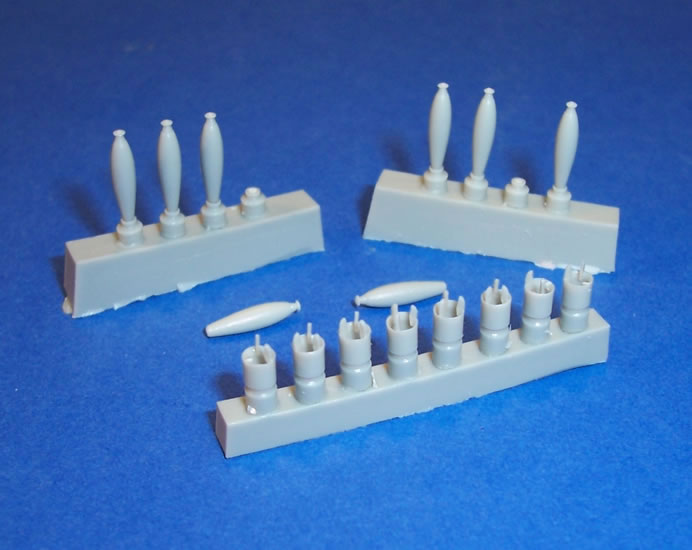
The PE fret provides no less than 55 detail parts, several of which dress up the cockpit. There are also tailplane struts, leading edge slat hinges and control linkages, and bomb-shackles.
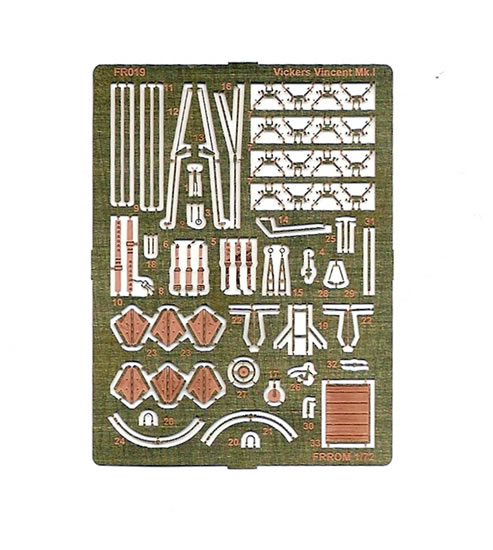
Taking a look at the main parts I was struck by how the wings are particularly nicely tooled with a realistic taught fabric effect. They also capture the variations in surface levels around the fuel tanks and the way the aileron’s section tapers where the hinge on the rear spars. The leading edge slats are moulded shut with the upper wing. I think this is acceptable because photos show them frequently closed on the ground as well as deployed. To cater for deployed slats more PE and resin parts would have been needed, and no doubt have added to cost.
The fuselage has restrained recessed surface detail, and correctly has the side and bottom fabric covering very taught and smooth. The inside of the fuselage halves features the metal frame structure for the length of the cockpit and beyond. The cockpit interior itself is very well catered for through a combination a styrene, resin and PE parts. These include more tubular structure, instrument panel, pilot’s controls including throttle and trim wheel, seat belts and obviously seats, the rear gun, its mount and spare ammo drums. The kit also provides the several clear small porthole windows and a windscreen.
The Vincent was based on the Vildebeest Mk.III, which introduced a third crewmember. I criticised the FRROM Vildebeest Mk.III kit for failing to provide the middle crewmember’s seat and associated cockpit paraphernalia; instead the sliding hatch in the decking over this position shut was moulded closed. So I was very pleased to see that the Vincent kit has the option of displaying this hatch open, and provides the additional cockpit detail required if this is done.
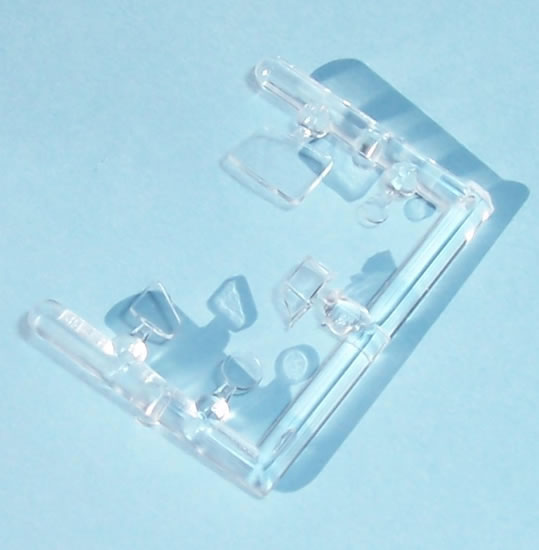
There is a choice of spatted or exposed wheels to cater for different decal options provided with the kit. The spats are moulded with their wheels, which is not an unusual compromise in this scale, and should look okay.
The large centreline fuel tank so characteristic of the Vincent is provided, along with the message hook associated with its General Purpose role. Most pleasing to see were the eight resin bombs and their styrene racks with PE shackles. So often releases from FRROM, Special Hobby, MPM etc. lack underwing loads. Indeed, I bemoaned the fact that the FRROM Vildebeest kits did not have bombs provided as well as a torpedo.
I would expect this kit to build well in a fashion typical of late FRROM or Special Hobby kits.
As 1/72 biplanes go this one has a couple of constructional advantages; it is reasonably large, has only one pair of inter-plane struts per wing and there’s no wing stagger. The strut mounting holes are there, but a bit difficult to see. They may need to be enlarged a little. The instructions direct the modeller to drill holes for the aileron linkages and provide dimensional locations for these. I can only think that the tooling for their holes was overlooked.
The resin engine is nicely done; as it needs to be with this subject since it is fully exposed. The inlet and exhaust manifolds are styrene as are the long exhaust pipes. The only major flash on the kit was on part of the exhaust manifold, but this does not present any real difficulties. There is also a resin oil cooler. Interestingly, the kit comes with two resin engines, although only one is mentioned in the parts map and instructions. One is clearly a Bristol Pegasus, whilst the other looks like a Bristol Perseus. The Pegasus applies to the early Mk.I to III Vildebeest and Vincent, whilst the Vildebeest Mk.IV used the Perseus. I now realise that I failed in my 2011 review of the FRROM Vildebeest Mk.III to realise that it had a Perseus rather than the correct Pegasus engine supplied. It seems only now with the Vincent release that FRROM have corrected this error.
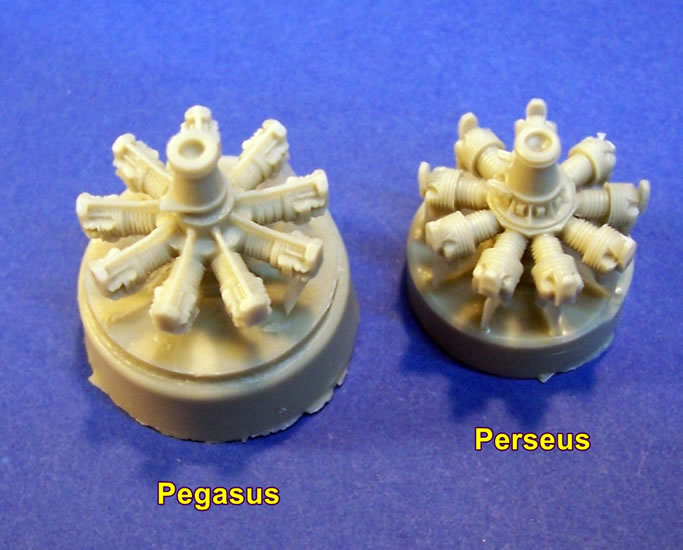
The power plant is finished off with a large two-blade styrene propeller. Propellers, especially those in limited-run kits, can be a pet-hate of mine. This kit’s is better than many, but somehow to my eye it’s still too slab-like and lacking the subtle changes of curvature apparent across the face of the blades. It may look better when painted, but could perhaps benefit from some re-shaping.
The kit has numerous very small PE details, these include little aileron mass balances (at least that’s what I think they are), aileron actuators, boarding step, gun ring elevation arms and so. All are details that add to this character of the resultant model, and suggest a good deal of research has gone into this kit.
Colours & Markings
Four attractive decal options are provided, and these can be viewed in colour at FRROM's website here:
- K4712, HV-L, of No 8 Sqn RAF, Khormaksar, Aden August 1940. This machine features a tri-colour shadow compensating camouflage scheme, which means six camouflage colours are used on the upper surfaces, over aluminium undersides.
- K6363, H, of No 244 Sqn RAF, Sharjah in the Persian Gulf,1942. Dark earth and middle stone camouflage upper surfaces over azure blue undersides.
- NZ344 of No 30 Sqn RNZAF, Gisborne, NZ, May-July 1943. Dark earth and dark green camouflage over duck-egg green undersides (these being NZ versions of the standard British colours).
- NZ322 of No 2 Service Flying Training School RNZAF, Woodbourne, NZ, March 1940-August 1941.Dark earth and dark green camouflage over aluminium fuselage sides and undersides (these being NZ versions of the standard British colours).
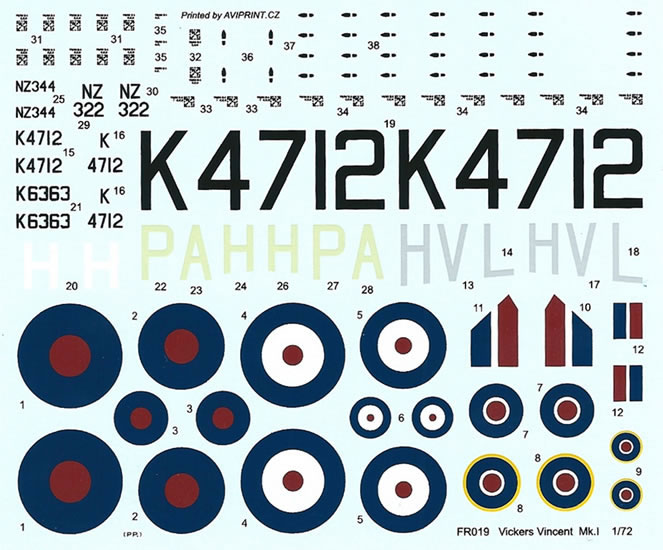
The decals also provide quite a number of stencils. The instructions provided a separate page of diagrams dedicated to placement of these decals. The decal sheet appears to be of very good quality.
This kit scores good marks in terms of research and execution. It has nice levels of detail, sensible kit design and use of different media, plus attractive colour schemes. The moulding and surface detail is very nicely done, and the cockpit detail is more than adequate for the scale and the size openings it is to be viewed through.
Some care will be needed in assembly, not only because it’s biplane, but also because there are quite a number of fiddly and delicate PE parts. Also the instructions require careful study just to determine where some things go and what choices are being identified.
It is pleasing to see that perhaps criticism of the FRROM Vildebeest MK III’s closed centre crew position and lack of bombs may have led to the inclusion of an open cockpit option and bombs with this kit.
It is great to finally have a really good quality injected kit of the Vincent. I am sure it will be welcomed by RAF and RNZAF fans alike. It should come as no surprise that I am recommending this kit very highly.
Thanks to Azur serie FRROM for the review sample.
Thanks to Azur serie FrRom for the review sample.
Review Text and Images Copyright © 2013 by Mark Davies
Page Created 3 June, 2013
Last updated
4 June, 2013
Back to HyperScale Main Page
Back to Reviews Page

|
